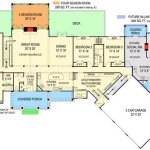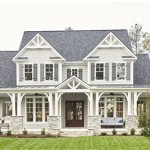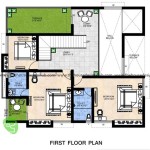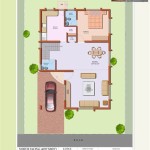Small House Plans For Empty Nesters: Downsizing for Comfort and Convenience
As children grow and leave the family home, many empty nesters find themselves with more space than they need. The upkeep and maintenance of a larger property can become burdensome, and the desire for a simpler, more manageable lifestyle often emerges. One popular solution is downsizing to a smaller home. Small house plans designed specifically for empty nesters offer a practical and appealing alternative, providing comfort, convenience, and financial freedom while still catering to the evolving needs of this life stage.
Small house plans are not simply scaled-down versions of larger residences. Instead, they are thoughtfully designed spaces that prioritize functionality, accessibility, and efficient use of square footage. They often incorporate features that address the unique requirements of empty nesters, such as single-level living, low-maintenance materials, and adaptable spaces for hobbies, guests, or potential future needs. This article will explore the key considerations when selecting small house plans for empty nesters, highlighting the benefits and design elements that contribute to a fulfilling and comfortable lifestyle.
Prioritizing Single-Level Living
One of the most significant advantages of small house plans for empty nesters is the opportunity to embrace single-level living. Eliminating stairs can dramatically improve accessibility and safety, particularly as mobility may decrease with age. A single-story layout provides ease of movement throughout the home, reducing the risk of falls and simplifying daily tasks. This design consideration is paramount for those planning to age in place, allowing them to remain in their homes comfortably and independently for longer.
Furthermore, single-level living facilitates a more open and interconnected floor plan. Common areas, such as the living room, dining area, and kitchen, can flow seamlessly together, creating a sense of spaciousness and promoting social interaction. This open concept design is particularly beneficial for empty nesters who enjoy entertaining guests or spending quality time with visiting family. It also simplifies cleaning and maintenance, as there are fewer separate rooms and levels to manage.
In addition to the practical benefits, single-level living can also contribute to a more relaxed and peaceful atmosphere. Without the constant need to navigate stairs, the home feels more grounded and stable. Noise transfer between floors is minimized, creating a quieter and more tranquil environment. This is especially important for empty nesters who may be seeking a respite from the hustle and bustle of their earlier lives.
Embracing Low-Maintenance Materials and Design
Another crucial aspect of small house plans for empty nesters is the incorporation of low-maintenance materials and design features. As individuals transition into retirement, they often have less time and energy to devote to home upkeep. Choosing durable and easy-to-clean materials can significantly reduce the burden of maintenance and free up time for other pursuits.
Exterior materials such as vinyl siding, brick, and fiber cement require minimal painting and are resistant to weathering and pests. Roofing materials like asphalt shingles with a long lifespan or metal roofing can also minimize the need for costly repairs. Replacing traditional lawns with drought-tolerant landscaping or hardscaping solutions can reduce water consumption and eliminate the need for frequent mowing and weeding.
Inside the home, consider using durable and stain-resistant flooring options such as tile, luxury vinyl plank (LVP), or engineered hardwood. These materials are easy to clean and maintain, and they can withstand the wear and tear of daily life. Quartz countertops are another excellent choice for kitchens and bathrooms, as they are non-porous, stain-resistant, and require minimal sealing. In bathrooms, walk-in showers with grab bars and low-threshold entries can enhance accessibility and safety while also being easier to clean than traditional bathtubs.
The overall design of the home should also prioritize low maintenance. Simplistic designs with clean lines and minimal ornamentation are easier to keep clean and clutter-free. Built-in storage solutions can help maximize space and minimize the accumulation of belongings, further reducing the need for constant tidying. Opting for energy-efficient windows and appliances can also reduce utility bills and minimize the need for repairs or replacements in the long run.
Creating Adaptable Spaces for Evolving Needs
While downsizing involves reducing the overall square footage, it's essential to create adaptable spaces that can accommodate the evolving needs of empty nesters. This includes designing rooms that can serve multiple purposes, incorporating flexible furniture, and considering potential future requirements for aging in place or accommodating visiting family members.
A spare bedroom can be designed as a multi-functional space, serving as a guest room, home office, or hobby room depending on the current needs. A murphy bed or sofa bed can be easily folded away when not in use, freeing up space for other activities. A dining area can also function as a workspace or craft area with the addition of a versatile table and comfortable seating. The key is to choose furniture that is easily movable and adaptable to different configurations.
As empty nesters plan for the future, it's important to consider potential accessibility needs. Widening doorways and hallways can accommodate wheelchairs or walkers if necessary. Installing grab bars in bathrooms and kitchens can provide added support and stability. Ensuring that light switches and outlets are easily accessible can also enhance convenience and safety. These modifications can be incorporated seamlessly into the design of the home, ensuring that it remains comfortable and functional for years to come.
Furthermore, empty nesters may want to consider designating a space for visiting family members, particularly grandchildren. This could be a dedicated guest room or a flex space that can be easily converted into a sleeping area. Incorporating features such as bunk beds or trundle beds can maximize sleeping capacity without taking up too much space. Creating a comfortable and welcoming environment for visiting family can help maintain close relationships and create lasting memories.
Small house plans for empty nesters are available in a wide range of styles and designs, from traditional to modern, and from cozy cottages to sleek contemporary homes. The key is to choose a plan that aligns with personal preferences, lifestyle needs, and budget. Working with an architect or designer who specializes in small house plans can help ensure that the final design is both functional and aesthetically pleasing.
Before selecting a small house plan, it's essential to carefully consider the specific needs and priorities of the empty nesters. This includes factors such as the desired location, the number of bedrooms and bathrooms, the need for a home office or hobby room, and the importance of outdoor living spaces. Creating a detailed list of requirements can help narrow down the options and ensure that the final choice is the right fit.
In addition to the floor plan, it's also important to consider the overall aesthetic of the home. Small house plans can be designed in a variety of styles, from traditional to modern, and from rustic to contemporary. Choosing a style that reflects personal tastes can help create a home that feels comfortable, inviting, and uniquely personal. The exterior design should complement the surrounding environment and fit in with the existing neighborhood aesthetic.
The cost of building a small house can vary depending on several factors, including the location, the size and complexity of the design, and the quality of the materials used. However, in general, small houses are less expensive to build than larger homes. This can free up financial resources for other pursuits, such as travel, hobbies, or retirement savings. Furthermore, smaller homes typically have lower property taxes, insurance costs, and utility bills, resulting in ongoing savings.
Downsizing to a small house can be a liberating and rewarding experience for empty nesters. It allows them to simplify their lives, reduce their financial burdens, and focus on the things that matter most to them. By carefully considering their needs and priorities and choosing a small house plan that is both functional and aesthetically pleasing, empty nesters can create a comfortable and fulfilling home for their next chapter.
Ultimately, the best small house plan for empty nesters is one that is tailored to their individual needs and preferences. It should be a space that is both comfortable and functional, and that allows them to live their lives to the fullest. With careful planning and thoughtful design, downsizing to a small house can be a positive and empowering experience.

Empty Nester House Plans Retirement The Designers

Empty Nester House Plans Retirement The Designers
:max_bytes(150000):strip_icc()/nautical-cottage-a415ead01c7141f2bb653b790b15b1f4.jpg?strip=all)
House Plans Under 1 800 Square Feet Perfect For Empty Nesters
:max_bytes(150000):strip_icc()/sl-2004_4cp_frontright_0-7fc4d68f01494c5f8cd449657af22329.jpg?strip=all)
House Plans Under 1 800 Square Feet Perfect For Empty Nesters

Empty Nesters Dream Home Bunch Interior Design Ideas

Empty Nester House Plans Retirement The Designers

112 Rustic Home Plans For Empty Nesters Craft Mart

Empty Nester House Plans Retirement The Designers

Empty Nester Farmhouse Plans Archives Craft Mart

Plan 057h 0036 The House








